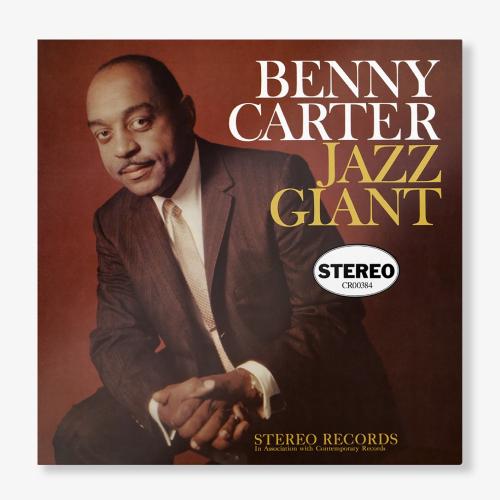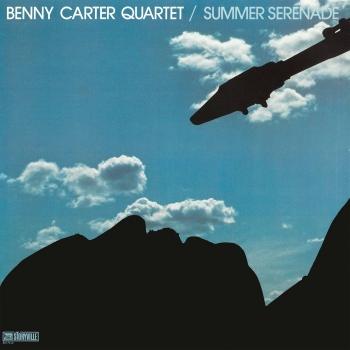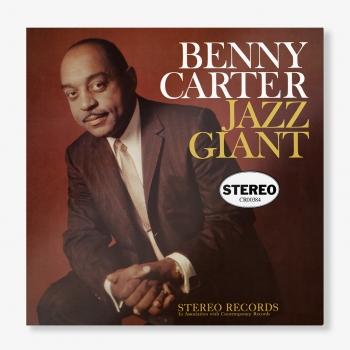
Jazz Giant (Remastered) Benny Carter
Album Info
Album Veröffentlichung:
1958
HRA-Veröffentlichung:
16.12.2022
Das Album enthält Albumcover
Entschuldigen Sie bitte!
Sehr geehrter HIGHRESAUDIO Besucher,
leider kann das Album zurzeit aufgrund von Länder- und Lizenzbeschränkungen nicht gekauft werden oder uns liegt der offizielle Veröffentlichungstermin für Ihr Land noch nicht vor. Wir aktualisieren unsere Veröffentlichungstermine ein- bis zweimal die Woche. Bitte schauen Sie ab und zu mal wieder rein.
Wir empfehlen Ihnen das Album auf Ihre Merkliste zu setzen.
Wir bedanken uns für Ihr Verständnis und Ihre Geduld.
Ihr, HIGHRESAUDIO
- 1 Old Fashioned Love 07:46
- 2 I'm Coming Virginia 05:47
- 3 A Walkin' Thing 05:59
- 4 Blue Lou 04:57
- 5 Ain't She Sweet 03:38
- 6 How Can You Lose 06:13
- 7 Blues My Naughty Sweetie Gives To Me 04:39
Info zu Jazz Giant (Remastered)
The 1958 classic Jazz Giant showcases the alto saxophone, trumpet and arrangements of triple threat Benny Carter, whose majestic talent awed four generations of jazz artists (he's joined by a formidable cast including Manne, Kessel and tenor sax titan Ben Webster).
Here, Carter displays three of his many talents, principally as an alto saxophonist, but also as a composer on two numbers and a trumpeter on two. The company he kept, with Webster and Frank Rosolino rounding out the front line, and such fellow giants as Andre Previn, Barney Kessel, Leroy Vinnegar, and Shelly Manne in the rhythm section (Jimmy Rowles replaces Previn on two tracks) left no doubt that this album would be a milestone in straight-ahead, small group, mainstream jazz.
Benny Carter was—with Johnny Hodges and Charlie Parker—one of the three original and major alto saxophonists in jazz up until the late Fifties. He was undoubtedly, as the title of this album suggests, a Jazz Giant.
The music in these sessions is unpretentious; bright, relaxed and buoyant, with an infectious swing. Everyone gets a chance to blow and show their worth. Carter plays with his characteristic lyricism, technical facility, and beauty of sound on alto, and—on two tracks—flawlessly on trumpet, his first love. Also, much like Ben Webster—another giant—he demonstrates his extraordinary melodic imagination. Frank Rosolino shows his inventive individuality, Barney Kessel plays with his usual lithe phrasing, laconic wit and consummate ease, and the rhythm section is never less than superior.
The last two tracks came to life in a happily fortuitous way, thanks to the greatness of the talents involved. Benny Carter had been set for the session, but became ill at the last minute. With Barney taking over as leader, the sidemen decided to use their time for some congenial, informal blowing. The unforgettable results include some of the finest work ever recorded by Webster and Rosolino in particular.
"Benny Carter had already been a major jazz musician for nearly 30 years when he recorded this particularly strong septet session for Contemporary. With notable contributions from tenor saxophonist Ben Webster, trombonist Frank Rosolino and guitarist Barney Kessel, Carter (who plays a bit of trumpet on "How Can You Lose") is in superb form on a set of five standards and two of his originals. This timeless music is beyond the simple categories of "swing" or "bop" and should just be called "classic." (Scott Yanow, AMG)
Benny Carter, alto saxophone, trumpet
Frank Rosolino, trombone (tracks 1–4, 6)
Ben Webster, tenor saxophone (tracks 1–4, 6)
André Previn, piano (tracks 1, 4–7)
Jimmy Rowles, piano (tracks 2, 3)
Barney Kessel, guitar
Leroy Vinnegar, double bass
Shelly Manne, drums
Digitally remastered by Bernie Grundman
Benny Carter
For over six decades, Benny Carter has occupied a unique place in American music. As Duke Ellington once wrote: "The problem of expressing the contributions that Benny Carter has made to popular music is so tremendous it completely fazes me, so extraordinary a musician is he."
As a soloist, Carter, along with Johnny Hodges, was the model for swing era alto saxophonists. He is nearly unique in his ability to double on trumpet, which he plays in an equally distinctive style. In addition, he is an accomplished clarinetist, and has recorded proficiently on piano and trombone. As an arranger, he helped chart the course of big band jazz, and his compositions, such as "When Lights Are Low" and "Blues In My Heart," have become jazz standards. Carter has also made major musical contributions to the world of film and television. His musicianship and personality have won him the respect of fellow artists and audiences on every continent.
Born in New York in 1907, Carter received his first music lessons on piano from his mother. He was attracted to the trumpet through his cousin, the legendary Cuban Bennett, and a neighbor, the great Ellington brass man Bubber Miley. Carter saved for months to buy a trumpet but, failing to master it over the weekend, he exchanged it for a C-melody saxophone. Frankie Trumbauer was an early inspiration to the young Benny, who was largely self-taught. By age fifteen, Carter was already sitting in at Harlem night spots.
Benny Carter made memorable impressions as a great bandleader and improviser with a highly influential style. Largely self-taught, Carter's first instrument was the trumpet, although the alto saxophone eventually became his principal instrument. Some of his earliest professional jobs were with bands led by cornetist June Clark and pianist Earl Hines, where his unusual ability to play both trumpet and saxophone was highly regarded. In 1930- 31 he spent a year with the Fletcher Henderson Orchestra, then for a short time he succeeded Don Redman as musical director of McKinney's Cotton Pickers. During the early 1930s, he also made his first recordings with the Chocolate Dandies, which included Coleman Hawkins. In 1932, Carter formed his own big band. At various times the band included such significant players as Ben Webster, Chu Berry, Teddy Wilson, Dicky Wells, Bill Coleman, and Sid Catlett.
In 1934, Carter dissolved his band, migrating to Europe the next year, where he served as a staff arranger for the BBC Orchestra in London until 1938. His work in Europe took on an ambassadorial tint, playing as a freelance soloist with musicians in England and France and leading a multiethnic band in Scandinavia in 1937. Growing restless, Carter returned to the U.S. in 1938 and assembled a new big band, which became the house band at the Savoy Ballroom through 1940. In 1942, with another new band in tow, he settled in Los Angeles, his longtime home base. With lucrative film studios calling, Carter began scoring films and television. He became one of the first African Americans to be employed in the field, easing the way for other black composers. His first film work was in 1943 on Stormy Weather.
Starting in 1946, with his composing and arranging skills in constant demand, Carter disbanded his orchestra and became largely a freelance player. He participated in tours with Jazz at the Philharmonic and wrote arrangements for major singers such as Ray Charles, Ella Fitzgerald, Peggy Lee, Sarah Vaughan, and Louis Armstrong. Many of his subsequent recordings, such as the widely hailed Further Definitions, were evidence of the depth of his composing and arranging mastery.
Carter has received numerous awards during his long lifetime, including a Grammy Lifetime Achievement Award in 1987, a DownBeat International Critics Poll in the arranger's category in 1988, Jazz Artist of the Year in both DownBeat and JazzTimes International Critics' polls in 1990, and the National Medal of Arts in 2000. In 1996, a documentary on Carter, Symphony in Riffs, was released.
Dieses Album enthält kein Booklet










